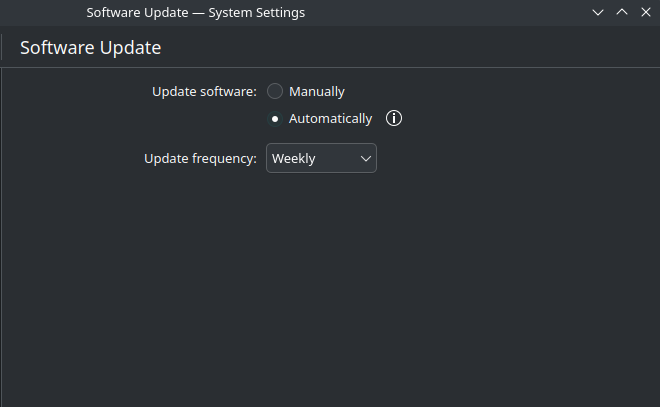endeavors
Holy shit
 acknowledgement??
acknowledgement??
endeavors
Holy shit
 acknowledgement??
acknowledgement??


Did a bit more research, was thinking it might be a systemd service, so I checked for timers there, but there was just a countme timer enabled that basically tells the server to include you in the count of active systems (how to disable, for the paranoid 🥸).
Then I went on to look at the live logs of rpm-ostree and, as found from this website used this command:
journalctl --follow --unit rpm-ostreed.service
So that I could monitor its activity while I open Discover and so I managed to record when it happens, I also saw from the logs that there is a configuration file at this path /etc/rpm-ostreed.confand that you can configure automatic updates from there, by default there a this line about it (usage greatly explained with man rpm-ostreed.conf btw):
[Daemon]
#AutomaticUpdatePolicy=none
but it’s commented out, so it couldn’t have been that.
Finally there is this one thing that pops up in the logs:
Initiated txn AutomaticUpdateTrigger for client(id:cli dbus:1.1625 unit:app-org.kde.discover@df0f43f8979843c0a34d36ad199c7eda.service uid:1000): /org/projectatomic/rpmostree1/fedora
So it is something triggered by Discover, as I had known already, due to other articles that talk about the integration with Discover, but I wasn’t so sure about it anymore, since I couldn’t find any related settings in the app.
So I found the setting that configures automatic updates in general… in the three dot menu (questionable UX decision?):

which actually just leads to the system settings:

I had this configured to be weekly, there isn’t even a setting as granular as seconds, the smallest span of time is daily, but what I’m guessing is that the “Update frequency” acts on when they should be installed automatically rather than when they should be fetched, so this is a limitation of the system as I understand it


Will do, hopefully there is one


Why so irritable? I’m just asking, I don’t even know German, I thought since you knew the video already, you could point me in the right direction, rather than me having to sift through it all while also passing it through a translator to hopefully (because I don’t know how well youtube’s auto-translate feature works) find the information I’m looking for in the whole presentation


On a quick skim I don’t see a way on it to set volume profiles, let alone program behavior based on certain events, is there some menu I might have missed?


So what I’m getting is that I would have to come up with something myself, right? I mean that would be super cool to do, but I don’t have the time to put into that, unfortunately


This is the architecture though, I’m asking about an application that can interact with it


55 minutes? Uhm, could you tell me the relevant section of the video, please?


nuff said.
I see, I guess that’s what happened to those that broke for me
I used to prefer GNOME, until I started using KDE daily on the desktop, I thought it would just be temporary, but I ended up liking KDE way more because of the features that are built-in, the integration is simply priceless and I’m tired of those GNOME extensions that keep breaking at the next GNOME major release and I have to wait weeks for the poor devs to catch up and fix them up to get the compatibility going again, in some ways that also happens on KDE with the widgets, but, arguably, you will need way fewer of those to extend the already wide functionality provided by the Fedora KDE experience, so you risk incurring in that issue a lot less. Note I specifically mention Fedora both because it’s the system you want and because the pool of apps included is the best for a streamlined, but not bloated, experience, which also allows me to use Kinoite without troubling myself to overlay crucial apps that aren’t provided (or don’t work fully) as Flatpak.
AGPL on documentation? What would that do?
Mental damage
Bro thought SIGTERM was enough
touch "\" \""


Oh I see, with the help of another thread I understood what that is
Locally integrated menu = menu in title bar
I guess the improvement that it provides is space saving right?
I agree, besides basic patterns to search for, that will most likely be necessary. In fact looking a bit more at this tool, it has a list of “rules” tailored to each software specifically, I guess this could be sustainable really only if a repository of third party extensions was kept so that anyone could contribute and the pool of rules expanded progressively
Origin story of the manguin
With that many Windows (gasp) ones, no… I’m afraid you are not